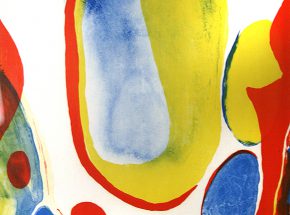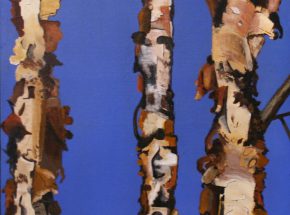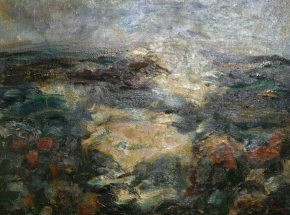

Françoise Gilot is one of the most enduring artists of the post World War II School of Paris. After deciding at the age of five that she wanted to be an artist, Gilot has plotted a course for her career which is interwoven with the evolution of modern art in the 20th Century. Françoise was born in Paris and raised in an environment that fostered interest in both the arts and the sciences – her father was a well-respected businessman and agronomist and her mother was an accomplished watercolorist. Although her father deemed that Françoise was to become an international lawyer, her independent spirit compelled her to lead a double life, secretly studying art instead of attending her morning law classes. A consuming passion to continue her studies solely in art further alienated her from her parents and Françoise sought the support of other family members establishing her first studio in the attic of her grandmother’s home in Paris.
Even at the young age of twenty-one, Gilot was one of the most respected artists of the emerging School of Paris, a movement struggling for recognition during the years of The Occupation. Then, in 1943, during the time of her first important exhibition in Paris, Gilot met Pablo Picasso, an artist forty years her senior. In 1946, Gilot and Picasso began a decade long relationship and Françoise became both a witness and a participant in one of the last great periods of the modern art movement in Europe. Their circle included poets, philosophers, writers, and many of the legends of the art world, such as Braque, Chagall, Cocteau, and Matisse. This artistic union was also shared with their two children, Claude and Paloma – whose antics and acrobatic postures were often captured in drawings and paintings. By late 1953, the relationship with Picasso had run its course and Gilot left the home she shared with him in Vallauris and returned to Paris with their children. In 1964, Françoise published Life with Picasso, and over a million copies were sold the first year. Life with Picasso has been translated into more than a dozen languages and it remains today a uniquely compelling and insightful observation about the human side of creative genius.
In 1969, during an exhibition in Los Angeles, Françoise traveled to La Jolla and was introduced to Dr. Jonas Salk. Their mutual admiration of architecture prompted Dr. Salk to offer Françoise a tour of The Salk Institute, the renowned research facility he had founded on the bluffs overlooking the pacific. Their courtship was brief — Françoise knew well the science of art and Jonas understood the art of science. With both their families in attendance, Paris was the site of a private wedding ceremony in June of 1970. During her 25-year marriage to Dr. Salk, Françoise Gilot maintained studios in La Jolla, New York and Paris and her career continued to evolve and thrive – her work further infused with maturity and discovery. In addition to strongly structured canvases, often composed with a dominant cadmium red, Gilot’s oeuvre expanded to include monumental “floating paintings,” luminous monotypes and strong, technically sophisticated color lithographs and aquatints.
Even after seventy years, Gilot continues to work as a painter wresting from form and color a visual statement that is at once both personal and universal. She is not content with the known; she views her task as an artist to transform and extend perceptions and to stimulate viewers towards new insights and experiences. In Gilot’s most recent paintings, the forces of nature, time and space are her preoccupations. Clearly, Gilot’s own explorations and achievements as an artist demonstrate how the vitality of a tradition can be maintained while simultaneously moving forward into the uncharted territories of the art world continuum.
Mel Yoakum, Ph.D.
Director, The F. Gilot Archives
http://www.francoisegilot.com/frames.html



